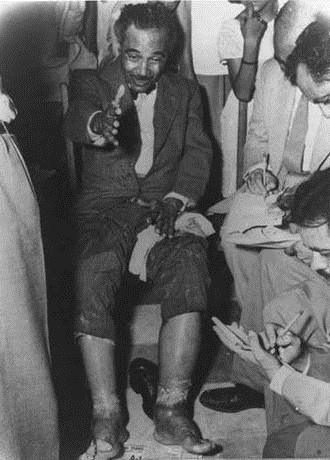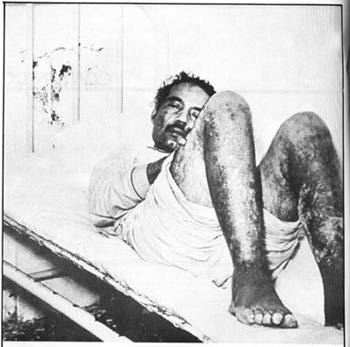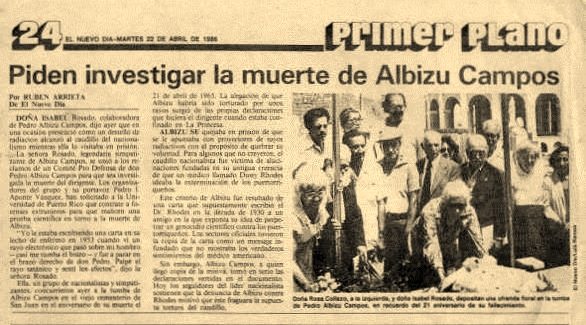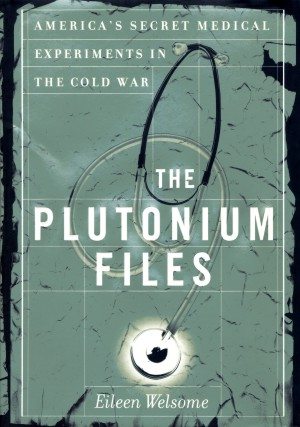There is a most unusual TV interview of Gov. Luis Muñoz Marín on YouTube. The interview occurred in March 1954, just after the Nationalist attack on U.S. Congress that was led by Lolita Lebrón. (NOTE: This video was shared on Facebook by the Fundación Luis Muñoz Marín in 2013.)
During that time, Muñoz Marín had rushed up to Washington, D.C. to assure the world that he (and the rest of Puerto Rico) did not condone the actions of these “lunatics, fanatics, fascists and Communists.” This is how Muñoz Marín described the Nationalists to The New York Times, prior to the TV interview.
The interview was an installment of Washington Merry Go Round, which was the 1950s equivalent of today’s 60 Minutes, Meet the Press or Face the Nation. It was moderated by Drew Pearson, the top political columnist of that era. For nearly 10 minutes, Muñoz Marín filled America with lies about Pedro Albizu Campos and the Nationalist movement in Puerto Rico.
The most shocking moment occurred from 7:15 to 8:45—a 90-second segment where he described Albizu Campos as a lunatic who constantly wrapped himself in cold wet towels, in order to protect himself from “mysterious machines throwing nuclear rays at him from a great distance.”
On national TV, Muñoz Marín and Pearson scoffed at this madman from Puerto Rico. The implicit message was that anyone who believed in the independence of Puerto Rico was as crazy as Albizu Campos.
But Albizu Campos was not crazy.
He was, in fact, being subjected to lethal TBI (Total Body Irradiation) in his prison cell. This radiation continued for several years, until it finally killed him.
On February 18, 1951, while in solitary confinement, Albizu saw “ribbons of light on all the walls, in all colors, brilliant as the aurora borealis. Sometimes it looked like a cascade of melted gold.” Then, for the first time in his life, he passed out. When he regained consciousness, he had a splitting headache and what felt like a full-body sunburn.
The next day the lights returned, and so did his headache. Sometimes there was no visible light, but he could feel the rays. After a week he noticed that each wave of radiation swelled his legs, hands, head, and whatever other part of his body it hit.
Within a few weeks, Albizu’s legs had swollen to elephantine proportions. His arms were covered with burn marks, and the skin was peeling from his hands and wrists. His feet, ankles and calves were swollen red balloons. His chest and back were covered with stripes, as if someone had flipped him over on a barbecue grill.
In every way, from every angle, Albizu Campos looked like he was burning alive.
Albizu notified the chief of La Princesa prison, Warden Juan Bravo, with a series of five letters in May 1951—but instead of diagnosing and treating his physical condition, they sent two psychiatrists who reported that Albizu was suffering from “an interpretive psychosis,” “overtones of paranoia” and “hallucinations of all his five senses.” In short, they declared him insane.
Two prisoners named Robert Díaz and Juan Jaca Hernández were temporarily moved into Albizu’s cell—and almost immediately started complaining of headaches and radiation burns. Three female prisoners in La Princesa —Ruth Reynolds, Doris Torresola and Carmen Pérez— reported humming motors, unexplained vibrations and electronic shocks directed at their heads while they slept.
Dr. Orlando Daumy, a renowned radiologist and president of the Cuban Cancer Association, examined Albizu and reached three findings:
- the sores on Albizu Campos were produced by radiation burns
- every symptom indicated a person who had undergone intense radiation
- wrapping himself in wet towels, was the best way for Albizu to diminish the intensity of the radiation
Dr. Daumy also produced some physical evidence: a small X-ray film showing the image of a paper clip. Daumy had placed a metal paper clip with this film on Albizu’s skin—and the clip was radiated into the film.
On another occasion, a Geiger counter placed next to Albizu’s head clicked so wildly that it broke the Geiger counter.
Warden Bravo tried to keep the entire matter quiet, but he failed. In 1952, the story exploded all over Latin America. In Puerto Rico, El Mundo reported that Albizu’s blood pressure had skyrocketed to 220/120, that he could scarcely walk, and that he suffered from “atomic torture.”
El Imparcial reported that Albizu’s feet, chest and stomach were severely inflamed, and the muscles in his neck were infected.
In Argentina, Verdad put Albizu on its front cover and ran an article headlined “The Atomic Lynching of a Martyr for Liberty,” which stated that “the apostle of Puerto Rican liberty is slowly being murdered in jail by means of electronic rays.”
In Mexico, Corrreo Indoamericano charged that “fatal rays are being used against Albizu Campos.”
In Cuba, Tiempo reprted that Albizu was the victim of a scientific plan to induce cerebral hemorrhage, cardiac collapse, or both… and that these attacks were producing visible burns on his extremities, swelling of his face, and a severe choking around the neck. The article concluded dramatically, “God knows that this is a lynching at the height of the atomic age.”
In 1953, the International Writers Congress of José Martí delivered a letter to U.S. President Dwight D. Eisenhower, demanding an investigation into the prison torture of Albizu Campos. The letter was signed by 28 prominent writers, journalists and intellectuals from 11 countries. The letter was ignored.
The Cuban House of Representatives passed a resolution acknowledging the “very grave state of the Puerto Rican patriot Pedro Albizu Campos,” and calling for his immediate release.
All of these international messages were ignored.
The U.S. government simply declared Albizu Campos “insane.” The prison guards laughed, and called him El Rey de las Toallas (The King of the Towels).
The radiation torture continued until March 27, 1956, when Albizu Campos finally suffered a cerebral thrombosis. The prison authorities waited two full days, until March 29, before taking him to San Juan Presbyterian Hospital. By this time, he was in a coma.
After that, for the last nine years of his life, Albizu Campos was unable to walk, unable to speak and the right side of his body was paralyzed.
Four decades later, a reporter for the Albuquerque Tribune named Eileen Welsome won the Pulitzer Prize for her exposé on U.S. government-sponsored radiation experiments from 1944 to 1974. In her book The Plutonium Files, Welsome detailed how the U.S conducted hundreds of secret radiation experiments on thousands of people (including prisoners), which inflicted intense suffering and premature death.
As reported by The New York Times, from World War II until the mid-1970s, 16,000 people were subjected to these radiation experiments throughout the United States. Many experiments were lethal, and many victims were prisoners.
Nearly 40 years after Albizu Campos’s death, his FBI files (carpetas) were declassified, and a veil of secrecy was finally lifted. These files show that Pedro Albizu Campos was one of those 16,000 people subjected to a radiation experiment…
…except that in Albizu’s case, it was no mere experiment.
It was a deliberate, slow-motion, atomic lynching.
Albizu Campos was subjected to lethal TBI for an extended period of time, until it finally killed him.
Governor Luis Muñoz Marín knew all about it.
He collaborated with the U.S. government in the torture and murder of Albizu Campos.
***
Nelson A. Denis is a former New York State Assemblyman and author of the upcoming book,War Against All Puerto Ricans.









Malditos abusadores…………… asesinar solo porque pensamos deferente a ellos y amamos la tierra donde nacimos. Como si ellos fueran los dueños del planeta. A que no lo hacen con un ruso o un chino………………. seguro que no …………… ahí no tienen ventajas. Siempre contra el mas débil .
[…] of U.S. and Canadian diplomats, recall an eerily similar case from Puerto Rican history, the strange and miserable death of Pedro Albizu Campos. In response to what he perceived as colonial injustices, unsanctioned corporate monopolies, and […]
[…] of U.S. and Canadian diplomats, recall an eerily similar case from Puerto Rican history, the strange and miserable death of Pedro Albizu Campos. In response to what he perceived as colonial injustices, unsanctioned corporate monopolies, and […]
[…] of U.S. and Canadian diplomats, recall an eerily similar case from Puerto Rican history, the strange and miserable death of Pedro Albizu Campos. In response to what he perceived as colonial injustices, unsanctioned corporate monopolies, and […]
[…] americanos e canadenses, lembram um caso assustadoramente semelhante da história porto-riquenha, a estranha e miserável morte de Pedro Albizu Campos. Em resposta ao que percebeu como injustiças coloniais, monopólios corporativos não sancionados […]
There wasn’t an ounce of communism in Don Pedro’s speeches. Muñoz Marìn and the rest of the murderers shall burn in hell for ever.
Also, it wouldn’t matter if he were a communist.
Disgusting They still believe we are slaves
[…] deadly attacks on labor and pro-independence uprisings; FBI surveillance, longterm imprisonment and torture of independence leaders; and forced sterilization […]
[…] deadly attacks on labor and pro-independence uprisings; FBI surveillance, longterm imprisonment and torture of independence leaders; and forced sterilization […]
[…] deadly attacks on labor and pro-independence uprisings; FBI surveillance, longterm imprisonment and torture of independence leaders; and forced sterilization […]
[…] deadly attacks on labor and pro-independence uprisings; FBI surveillance, longterm imprisonment and torture of independence leaders; and forced sterilization […]
[…] deadly attacks on labor and pro-independence uprisings; FBI surveillance, longterm imprisonment and torture of independence leaders; and forced sterilization […]
[…] deadly attacks on labor and pro-independence uprisings; FBI surveillance, longterm imprisonment and torture of independence leaders; and forced sterilization […]
A warning about hidden,terroristic activity..
Do you have any information about a criminal method called electronic,radio frequency harrassment v2k directed voices to the hearing through implanted micro frequency devices inside the ear?I have discovered corrupted police departments,local authorities in the states of Michigan and Indiana and they are and have being committed this illegal,criminal activity on individual’s in this areas, among other crimes..
A very serious warning, ….Hidden Terrorism,Corruption, Extortion, organized crime, by police,sheriff’s departments from the areas of Sturgis Michigan and Lagrange Indiana,st Joseph county Michigan,lagrange county Indiana and a company named Morgan Olson.They are committing criminal and terroristic activity and want to keep it hidden and unpunished. This criminals use a criminal method called Electronic Harassment,radio frequency harrassment through the insertion of micro frequency devices inside well hidden in individual’s ears.Then this criminals keep communication with individuals by forcement 24/7 with projected noice,voices,frequencies to a individual’s
hearing, for sleep deprivation, Extortion, Manipulation, torture,terrorism, Induced Thoughts,induce suicide, inflict mental disease. harass, inflict pain,false imprisonment, death.similar to the sonic attacks,”Havana Síndrome”,that occurred to the American diplomats in Cuba,China.A systematic campaign … to emotionally and psychologically terrorize. They are committing sex trafficking,rape,torture,extortion,drug trafficking,organized crime,hate crimes,terroristic activity among other crimes.They are a serious threat,danger. ….